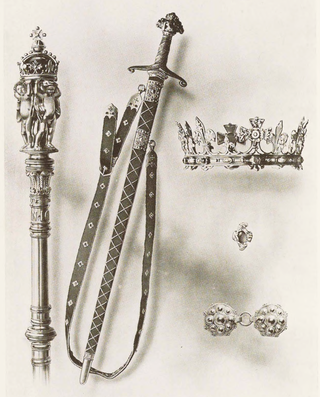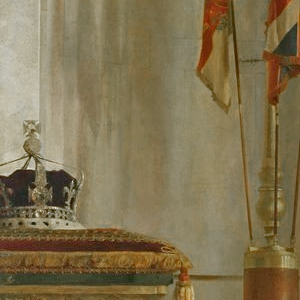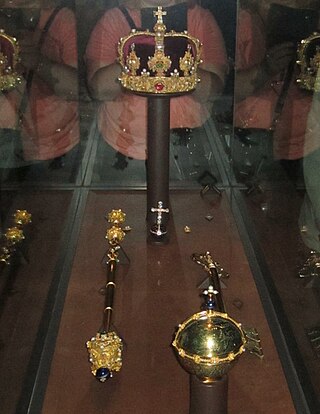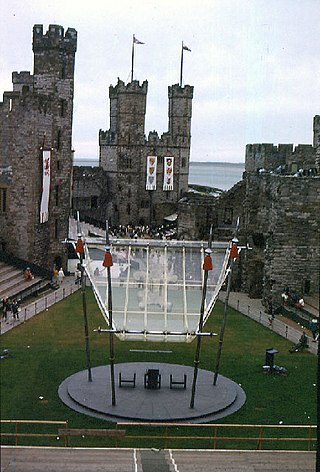
Prince of Wales is a title traditionally given to the male heir apparent to the English and, later, British thrones. The title originated with the Welsh rulers of Gwynedd who, from the late 12th century, used it to assert their supremacy over the other Welsh rulers. However, to mark the finalisation of his conquest of Wales, in 1301, Edward I of England invested his son Edward of Caernarfon with the title, thereby beginning the tradition of giving the title to the heir apparent when he was the monarch's son or grandson. The title was later claimed by the leader of a Welsh rebellion, Owain Glyndŵr, from 1400 until 1415.

Crown jewels are the objects of metalwork and jewellery in the regalia of a current or former monarchy. They are often used for the coronation of a monarch and a few other ceremonial occasions. A monarch may often be shown wearing them in portraits, as they symbolize the power and continuity of the monarchy. Additions to them may be made, but since medieval times the existing items are typically passed down unchanged as they symbolize the continuity of the monarchy.

The Crown Jewels of the United Kingdom, originally the Crown Jewels of England, are a collection of royal ceremonial objects kept in the Jewel House at the Tower of London, which include the coronation regalia and vestments worn by British monarchs.

St Edward's Crown is the centrepiece of the Crown Jewels of the United Kingdom. Named after Saint Edward the Confessor, versions of it have traditionally been used to crown English and British monarchs at their coronations since the 13th century.

The Imperial State Crown is one of the Crown Jewels of the United Kingdom and symbolises the sovereignty of the British monarch. It has existed in various forms since the 15th century. The 1937 version is worn by a new monarch for the first time in the royal procession following their coronation and subsequently used at State Openings of Parliament. The crown is adorned with 3,170 precious stones, including the Cullinan II diamond, St Edward's Sapphire, the Stuart Sapphire, and the Black Prince's Ruby.

The Honours of the Principality of Wales are the regalia used at the investiture of the Prince of Wales, as heir apparent to the British throne, made up of a coronet, a ring, a rod, a sword, a girdle and a mantle. All but the coronet date from the investiture of Prince Edward in 1911 when most of the Honours of Wales were redesigned.

The Crown of Queen Elizabeth The Queen Mother, also known as the Queen Mother's Crown, is the crown made for Queen Elizabeth to wear at her coronation in 1937 and State Openings of Parliament during the reign of her husband, King George VI. The crown was made by Garrard & Co., the Crown Jeweller at the time, and is modelled partly on the design of the Crown of Queen Mary, though it differs by having four half-arches instead of the eight that Queen Mary's Crown originally had. As with Queen Mary's Crown, its arches are detachable at the crosses pattée, allowing it to be worn as a circlet or open crown. It is the only crown for a British king or queen to be made of platinum.

The regalia of Norway are items that symbolise the Norwegian monarch's power and majesty. Little is known of the old Norwegian regalia which have since been lost. The majority of the modern regalia date from 1818 and were made for the coronation of Jean Bernadotte as King Carl III Johan.

The State Crown of George I is the imperial and state crown crafted in 1714 for King George I. It was modified and used by subsequent monarchs until 1838. The empty gold frame and its aquamarine monde which dates from the reign of King James II are both part of the Crown Jewels of the United Kingdom. They are on public display in the Martin Tower at the Tower of London.

Llywelyn's coronet is a lost treasure of Welsh history. It is recorded that Llywelyn ap Gruffudd, Prince of Wales and Lord of Aberffraw had deposited this crown and other items with the monks at Cymer Abbey for safekeeping at the start of his final campaign in 1282. He was killed later that year. It was seized alongside other holy artefacts in 1284 from the ruins of the defeated Kingdom of Gwynedd. Thereafter it was taken to London and presented at the shrine of Edward the Confessor in Westminster Abbey by King Edward I of England as a token of the complete annihilation of the independent Welsh state.

Garrard & Co. Limited, formerly Asprey & Garrard Limited, designs and manufactures luxury jewellery and silver. George Wickes founded Garrard in London in 1735 and the brand is headquartered at Albemarle Street in Mayfair, London. Garrard also has a presence in a number of other locations globally. Garrard was the first official and most notably important Crown Jeweller of the United Kingdom having supplied jewels for Queen Victoria herself, and was charged with the upkeep of the British Crown Jewels, from 1843 to 2007, and was responsible for the creation of many tiaras and jewels still worn by the British royal family today. As well as jewellery, Garrard is known for having created some of the world's most illustrious sporting trophies, including the Americas Cup, the ICC Cricket World Cup Trophy and a number of trophies for Royal Ascot in its role as Official Trophies and Silverware Supplier, which originally dates back to the first Gold Cup in 1842.

Sweden's regalia are kept deep in the vaults of the Royal Treasury, underneath the Royal Palace in Stockholm, in a museum that is open to the public. The crowns and coronets have not been worn by Swedish royalty since 1907, but they are still displayed at weddings, christenings and funerals.

The current Crown of the Netherlands is of relatively modern origin. In 1813 the new "Sovereign Ruler" of the Netherlands, Prince Willem of Orange, son and heir of the exiled stadtholder Willem V of Orange, was sworn in as Dutch monarch in Amsterdam. There was no crown present at the ceremony.

The Prince of Wales is sometimes presented and invested with the insignia of his rank and dignity in the manner of a coronation. The title is usually given to the heir apparent of the English or British throne. An investiture is ceremonial, as the title is formally conferred via letters patent issued by the monarch.

Queen Elizabeth II owned a historic collection of jewels – some as monarch and others as a private individual. They are separate from the gems and jewels of the Royal Collection, and from the coronation and state regalia that make up the Crown Jewels.

The Dunstable Swan Jewel is a gold and enamel brooch in the form of a swan made in England or France in about 1400 and now in the British Museum, where it is on display in Room 40. The jewel was excavated in 1965 on the site of Dunstable Friary, and is presumed to have been intended as a livery badge given by an important figure to his supporters; the most likely candidate was probably the future Henry V of England, who was Prince of Wales from 1399.
Louis Osman was an English artist, architect, goldsmith, silversmith and medallist. He is notable for the gold coronet he designed and made for the investiture in 1969 of Charles, Prince of Wales. His work as a goldsmith puts him amongst the top artists in his field with his valuable and important works held in church, civic and private collections worldwide.

The coat of arms of the Prince of Wales is the official personal heraldic insignia of the Princes of Wales, a title traditionally granted to the heir apparent of the reigning monarch of the United Kingdom of Great Britain and Northern Ireland, formerly the Kingdom of Great Britain and before that the Kingdom of England.

The jewels of Anne of Denmark (1574–1619), wife of James VI and I and queen consort of Scotland and England, are known from accounts and inventories, and their depiction in portraits by artists including Paul van Somer. A few pieces survive. Some modern historians prefer the name "Anna" to "Anne", following the spelling of numerous examples of her signature.

The investiture of Charles, Prince of Wales, took place in Caernarfon Castle, north Wales, on 1 July 1969. The ceremony formally presented the title of Prince of Wales to the 20-year-old Charles, eldest son of Queen Elizabeth II. He was the 21st heir to the English or British throne to hold the title. The investiture was a revival of a ceremony which had first been used for the previous prince of Wales, Edward, in 1911. The 1969 event was watched by 500 million people worldwide on television, but it received opposition in particular from Welsh nationalist organisations.



















